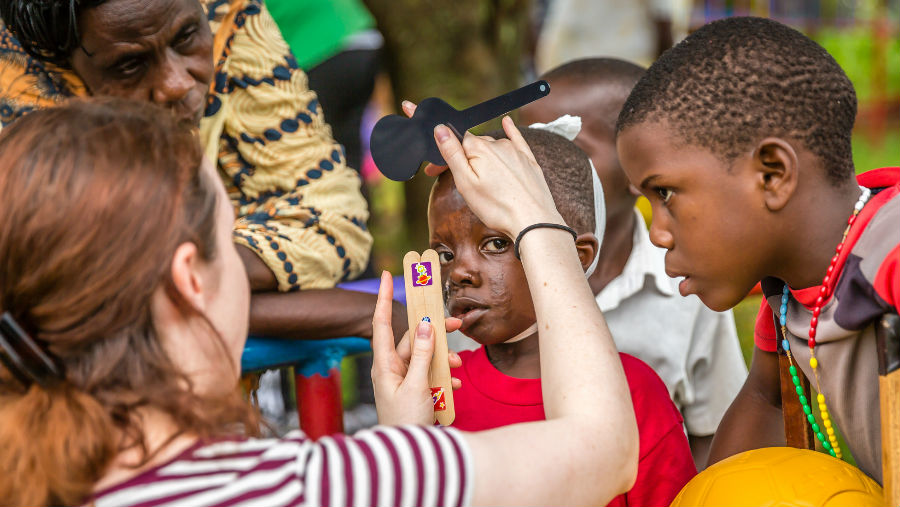Join the Leading Global Eye Health Alliance.
Membership-
Choose an alternate language here
[vc_row][vc_column][vc_column_text] In 1992 the World Health Organization estimated that there were 1.5 million children who were blind from eye conditions worldwide, stating that this estimate was based on limited epidemiological data1. At that time, measles infection and vitamin A deficiency were considered the most important avoidable causes. In 2000 WHO reviewed the evidence and the estimate was revised, after it was realized the prevalence of blindness in children is associated with under 5 mortality rates 2. At that time there were estimated to be 1.4 million blind children, with retinal diseases and corneal scarring being the commonest causes.[/vc_column_text][/vc_column][/vc_row][vc_row][vc_column width=”1/2″][vc_line_chart x_values=”1992; 2000; 2010; 2018″ values=”%5B%7B%22title%22%3A%22Number%20in%20million%22%2C%22y_values%22%3A%221.5%3B1.4%3B1.26%3B1.02%22%2C%22color%22%3A%22blue%22%7D%5D” title=”Childhood blindness across the years”][/vc_column][vc_column width=”1/2″][vc_column_text]Since then we have revised the estimates again, but these have not been published by WHO. The revised estimates suggest that the magnitude has continued to fall, to 1.26 million in 20103 and to 1.025 million in 20184. The majority of blind children now live in countries classified by the World Bank as lower-middle income (53% of the total), and the four main groups of causes are retinal diseases, lesions of the whole eye (e.g., microphthalmos), cataract and corneal scarring4. Data on the causes of blindness for the most recent estimate came from studies involving almost 27,000 blind children which were published between 2000 and 2018.[/vc_column_text][/vc_column][/vc_row][vc_row][vc_column][vc_column_text]The main drivers of the declining magnitude are increasing socioeconomic development and greater coverage of programmes for the control of vitamin A deficiency and measles infection, all of which have contributed to declining under 5 mortality rates, particularly in low- and middle-income countries. These changes are happening at the same time as access to specialist eye care for children is increasing, and the number of children in the world is beginning to plateau at around 2.0 billion.
In 1992 the World Health Organization estimated that there were 1.5 million children who were blind from eye conditions worldwide, stating that this estimate was based on limited epidemiological data1. At that time, measles infection and vitamin A deficiency were considered the most important avoidable causes. In 2000 WHO reviewed the evidence and the estimate was revised, after it was realized the prevalence of blindness in children is associated with under 5 mortality rates 2. At that time there were estimated to be 1.4 million blind children, with retinal diseases and corneal scarring being the commonest causes.[/vc_column_text][/vc_column][/vc_row][vc_row][vc_column width=”1/2″][vc_line_chart x_values=”1992; 2000; 2010; 2018″ values=”%5B%7B%22title%22%3A%22Number%20in%20million%22%2C%22y_values%22%3A%221.5%3B1.4%3B1.26%3B1.02%22%2C%22color%22%3A%22blue%22%7D%5D” title=”Childhood blindness across the years”][/vc_column][vc_column width=”1/2″][vc_column_text]Since then we have revised the estimates again, but these have not been published by WHO. The revised estimates suggest that the magnitude has continued to fall, to 1.26 million in 20103 and to 1.025 million in 20184. The majority of blind children now live in countries classified by the World Bank as lower-middle income (53% of the total), and the four main groups of causes are retinal diseases, lesions of the whole eye (e.g., microphthalmos), cataract and corneal scarring4. Data on the causes of blindness for the most recent estimate came from studies involving almost 27,000 blind children which were published between 2000 and 2018.[/vc_column_text][/vc_column][/vc_row][vc_row][vc_column][vc_column_text]The main drivers of the declining magnitude are increasing socioeconomic development and greater coverage of programmes for the control of vitamin A deficiency and measles infection, all of which have contributed to declining under 5 mortality rates, particularly in low- and middle-income countries. These changes are happening at the same time as access to specialist eye care for children is increasing, and the number of children in the world is beginning to plateau at around 2.0 billion.
However, each revised estimate is based on limited population-based prevalence estimates. In addition, although more population-based data are now available on the causes of blindness from studies using the key informant method, most of the data still come from examining children in schools for the blind. More data are needed on the epidemiology of blindness in children, and studies which use a range of sources of data are recommended.
In 2004 it was estimated that 12.8 million children aged 5-15 years were vision impaired from uncorrected refractive errors5, but no data are available on the prevalence and magnitude of vision impairment from other eye conditions. More studies are also required to address this important gap.
Image on top: Orthoptist checking visual acuity of child burnt as a result of falling into cooking fire/ Terry Cooper[/vc_column_text][/vc_column][/vc_row]